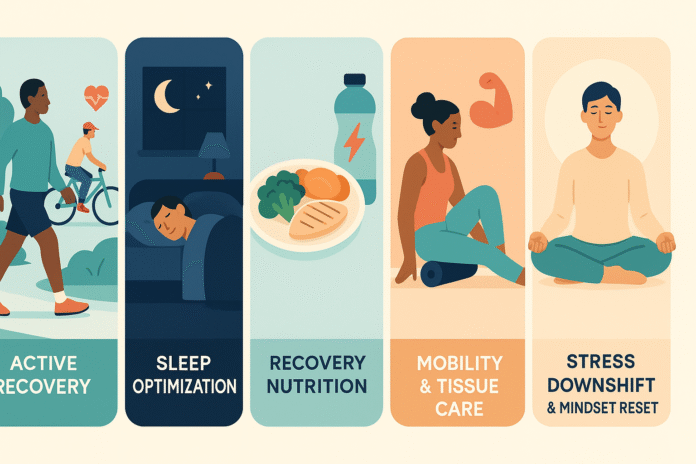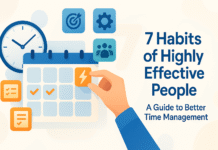You don’t get fitter during hard sessions—you get fitter when you recover from them. Rest days are where your body repairs tissues, consolidates training adaptations, restores energy, and recalibrates your mind. If you’ve ever asked, “What should I actually do on a rest day?” this guide is for you. Below you’ll learn five evidence-informed strategies to make rest days work harder for you, without turning them into secret training days. You’ll also get step-by-step how-tos, beginner modifications, safety notes, a quick-start checklist, troubleshooting, ways to measure progress, and a four-week starter plan.
Disclaimer: The information below is educational and not a substitute for medical advice. If you have a health condition, injury, or concerns about exercise or recovery, consult a qualified professional.
Key takeaways
- Keep rest active, not intense. Light movement boosts circulation and eases stiffness without adding real fatigue.
- Prioritize sleep. Seven or more hours nightly supports overall recovery and performance.
- Fuel recovery. On easier days, emphasize protein, smart carbs, and fluids/electrolytes to replenish and repair.
- Restore mobility & tissue quality. Short sessions of mobility work and self-massage can improve range of motion and reduce soreness.
- Downshift stress. Breathwork and mindful practices calm the nervous system and improve sleep and readiness.
1) Active Recovery: Move Lightly to Feel Better, Not Tired
What it is & why it works
Active recovery is low-intensity movement (think easy walking, cycling, or mobility flow) that increases blood flow, reduces perceived stiffness, and helps you feel better by your next hard workout. Research shows that gentle movement can enhance blood lactate removal versus total rest after demanding sessions, although its impact on next-day performance varies. The practical translation: use light, conversational-pace activity to feel looser and more refreshed.
Requirements & low-cost alternatives
- Equipment: None required. Walking shoes or a bike are nice.
- Space: Indoors or outdoors.
- Cost: Free.
Step-by-step implementation (beginner friendly)
- Pick a mode you enjoy (walk, easy spin, gentle swim, mobility flow).
- Set intensity to “conversational.” You can talk comfortably the whole time (the “talk test” places you in Zone 1).
- Go short and easy. Start with 20–30 minutes.
- Finish with 5–10 minutes of easy joint mobility (ankle circles, hip openers, thoracic rotations).
Beginner modifications & progressions
- If very sore: Start with 10–15 minutes of relaxed walking and a few mobility drills.
- Progression: Build to 30–40 minutes of easy movement, or split into two 15–20 minute bouts.
- Cross-training: Rotate modes (walk Monday, bike Thursday) to reduce joint monotony.
Frequency, duration & metrics
- Frequency: 1–3 active recovery sessions per rest day or across easy days.
- Duration: 15–40 minutes per session.
- Metrics: Keep effort “easy convo pace,” RPE 3–4/10. If you track HRV or resting HR, look for stability or improvement by the next training day.
Safety, caveats & common mistakes
- Don’t creep up intensity. If you’re breathing hard, you’re not recovering.
- When in doubt, do less. If fatigue is high or sleep was poor, reduce duration.
- Avoid “extras” that feel like another workout (battle ropes, sprints, long hills).
Sample mini-plan
- A) 25-minute easy walk ➜ 5 minutes of ankle/hip mobility.
- B) 20-minute light spin ➜ 3 rounds of cat-camel, thoracic openers, shoulder circles.
2) Sleep Optimization: The Highest-ROI Recovery Tool
What it is & why it works
Sleep is the foundation of recovery. Adults should aim for seven or more hours per night on a regular basis to support health, cognition, and physical performance. Better sleep quality and regularity help your body repair tissues, regulate hormones, and restore the nervous system—critical on rest days and every day.
Requirements & low-cost alternatives
- Equipment: Dark, cool, quiet bedroom; an alarm; optional eye mask or earplugs.
- Cost: Minimal—optimize your environment before buying tech.
Step-by-step implementation
- Anchor your schedule. Set a consistent wake time 7 days/week.
- Build a 30–45 minute wind-down. Screens off, lights dim, read or stretch gently.
- Keep it cool & dark. Aim for a cooler room and blackout curtains or mask.
- Caffeine timing: Reduce late-day intake if it disrupts your sleep.
- If your mind races: Try 5–10 minutes of slow nasal breathing (about 6 breaths/min) or a short body scan.
Beginner modifications & progressions
- Start small: Protect just your wake time for a week.
- Then add: 15 minutes of wind-down.
- Progress: Extend to a consistent 30–45 minute routine and aim for 7–9 hours in bed.
Frequency, duration & metrics
- Frequency: Nightly.
- Duration target: 7–9 hours in bed; consistent schedule.
- Metrics: Sleep duration, sleep quality rating (1–5), daytime sleepiness, and training readiness.
Safety, caveats & common mistakes
- Don’t chase perfect. Consistency beats gadgets.
- Avoid long naps if they harm nighttime sleep (short 10–20 min power naps are fine for many).
- Seek help for snoring, apnea, or persistent insomnia.
Sample mini-plan
- A) 9:30 pm devices off ➜ warm shower ➜ 10 minutes of slow breathing in bed ➜ lights out.
- B) AM sunlight exposure + walk for 10–15 minutes to reinforce circadian timing.
3) Recovery Nutrition & Hydration: Rebuild, Refill, Rehydrate
What it is & why it works
Training depletes fuel and disrupts muscle proteins. Rest days are prime time to rebuild (adequate protein), refill (appropriate carbohydrates), and rehydrate (fluid + electrolytes), setting you up for your next quality session.
Requirements & low-cost alternatives
- Equipment: Kitchen basics, water bottle, simple scale for body-mass checks pre/post tough training (for hydration planning).
- Cost: Regular groceries; no supplements required for most people.
Step-by-step implementation
- Hit your protein target. Across the day, aim for a total intake that supports your goals. A widely cited meta-analysis suggests benefits up to roughly ~1.6 g/kg/day for maximizing muscle adaptations in resistance training contexts; many athletes operate in a practical ~1.2–2.0 g/kg/day range depending on training and goals.
- Match carbs to training load. On rest/light days, keep carbs toward the lower end of athlete guidelines (e.g., ~3–5 g/kg/day), scaling up on heavy days.
- Hydrate intelligently. Day to day, drink to thirst and include electrolytes with meals. After big sweat losses, rehydrate with ~1.25–1.5 L per kg of body mass lost and include sodium to improve fluid retention.
- Distribute protein across meals. Include a protein source at breakfast, lunch, dinner, and optionally a snack.
- Focus on whole foods. Colorful plants, quality proteins, and minimally processed carbs.
Beginner modifications & progressions
- Beginner: Add one palm-sized protein serving per meal; carry a water bottle.
- Progress: Plan rest-day meals with protein + produce + slow carbs; adjust carbs based on training volume.
- Advanced: Track body-mass change across hard sessions to personalize rehydration.
Frequency, duration & metrics
- Frequency: Every rest day (and training day).
- Metrics: Daily protein grams; subjective energy; body-mass change after hard sessions; urine color (aim for pale straw most of the day).
Safety, caveats & common mistakes
- Don’t under-fuel. Low energy availability worsens recovery and performance.
- Avoid swinging from restriction to binge. Keep meals regular.
- Beware “chronic ice baths” for lifters (see Section 4)—they can blunt long-term strength/hypertrophy adaptations; prioritize nutrition and sleep first.
Sample mini-plan (rest day plate ideas)
- A) Omelet with vegetables + whole-grain toast; yogurt with berries; lentil-veggie bowl; salmon, rice, and salad.
- B) Hydration touchpoints with meals + an extra glass of water mid-morning and mid-afternoon.
4) Mobility & Tissue Care: Move Better, Ache Less
What it is & why it works
Rest days are a perfect slot for gentle mobility (joint range-of-motion work) and tissue care (self-massage/foam rolling). Evidence suggests foam rolling can improve flexibility and modestly reduce soreness without impairing performance. Traditional static stretching, by contrast, shows limited effect on soreness reduction; use it for range of motion, not pain relief.
Requirements & low-cost alternatives
- Equipment: Yoga mat, foam roller or massage ball (a rolled towel or water bottle works in a pinch).
- Space: Living room floor.
- Cost: Low.
Step-by-step implementation (20 minutes)
- Spine & hips (6–8 min): Cat-camel, 90/90 hip switches, thoracic openers.
- Ankles & shoulders (6–8 min): Ankle rocks, wall dorsiflexion, shoulder circles, band pull-aparts.
- Self-massage (4–6 min): Calves, quads, glutes, lats—30–60 sec per area, 1–2 passes, gentle pressure.
Beginner modifications & progressions
- Beginner: 10 minutes total (pick 3–4 drills).
- Progress: 20–30 minutes; add targeted foam rolling to the most fatigued regions.
Frequency, duration & metrics
- Frequency: 2–5 days/week, with at least one rest day session.
- Duration: 10–30 minutes.
- Metrics: Simple range-of-motion checks (e.g., overhead reach), soreness rating (0–10), ease of next-day warm-ups.
Safety, caveats & common mistakes
- Don’t grind painful spots. Aim for mild–moderate pressure.
- Avoid long static stretches before power sessions; save deep holds for after training or on rest days.
- Be patient. Mobility improves with consistency.
Sample mini-plan
- A) 12-minute mobility flow ➜ 6 minutes of light foam rolling.
- B) “Desk reset” (5 minutes): thoracic opener on the floor, hip flexor stretch, ankle rocks.
5) Stress Downshift & Mindset Reset: Train Your Recovery System
What it is & why it works
Your autonomic nervous system (ANS) has two gears: sympathetic (“go”) and parasympathetic (“recover”). Rest days are ideal for slow breathing, mindfulness, and light reflection, all of which can increase heart-rate variability (a marker of parasympathetic activity), improve sleep quality, and reduce perceived stress. This mental reset prevents you from carrying life stress into training fatigue.
Requirements & low-cost alternatives
- Equipment: None. Optional breathing app or timer.
- Space: Quiet corner.
- Cost: Free.
Step-by-step implementation (10–15 minutes)
- Sit comfortably, nasal breathe. Inhale ~5 seconds, exhale ~5 seconds (~6 breaths/min).
- Set a timer for 5–10 minutes. Keep the breath smooth, light, and low (belly/ribs).
- Mindfulness cool-down (3–5 minutes). Brief body scan or gratitude note; release to-do list clutter.
Beginner modifications & progressions
- Beginner: 3 minutes of slow breathing after your active recovery walk.
- Progress: 10–15 minutes most days; add a short mindfulness session before bed.
- Optional: Journal two wins from the week + one focus for tomorrow’s session.
Frequency, duration & metrics
- Frequency: 4–7 days/week; more on rest days.
- Duration: 5–15 minutes.
- Metrics: Subjective calm (0–10), sleep quality, morning readiness (RPE for warm-ups), optional HRV if you track it.
Safety, caveats & common mistakes
- Don’t overthink technique. Gentle, consistent practice beats perfection.
- If you get dizzy, stop and return to normal breathing.
- Apps are tools, not requirements. A simple timer works.
Sample mini-plan
- A) 10 minutes of 5-5 breathing ➜ 3-minute body scan.
- B) 8 minutes slow breathing after your evening walk to wind down.
Quick-Start Checklist (Print-worthy)
- One 20–30 minute easy movement session (conversational pace).
- 7+ hours in bed tonight; 30-minute wind-down planned.
- Protein at each meal; carbs matched to a light day; carry water.
- 10–20 minutes of mobility + 4–6 minutes of gentle foam rolling.
- 5–10 minutes of slow breathing or mindfulness practice.
- Jot a note: how you feel today (energy, mood, soreness) for tracking.
Troubleshooting & Common Pitfalls
“Active recovery turns into another workout.”
Dial back to true Zone 1 (you can comfortably talk). Keep sessions short. If you use RPE, aim for 3–4/10.
“I’m still sore after 48–72 hours.”
DOMS often peaks 24–72 hours after novel or hard training. Use light movement, mobility, sleep, and smart fueling. If soreness is severe or persists beyond a week, review your training load or consult a professional.
“I sleep 6 hours and feel wrecked.”
Protect your wake time first, then build a consistent 30–45 minute wind-down. Reduce late-day caffeine if it affects you.
“Foam rolling hurts—am I doing damage?”
Use mild–moderate pressure and short bouts (30–60 sec per area). It shouldn’t feel like punishment.
“Should I take ice baths on rest days?”
Cold-water immersion may reduce soreness acutely but can blunt long-term hypertrophy/strength gains if used regularly after lifting. Use sparingly if muscle size/strength are priorities.
“I don’t have time.”
Combine habits: 20-minute walk outside (sunlight + movement) ➜ 5-minute mobility ➜ 5-minute breathing. That’s 30 minutes total.
“Nutrition confuses me.”
Keep it simple: protein every meal, colorful plants, slow carbs as needed, fluids with meals. Rehydrate more after big sweat losses.
How to Measure Recovery & Readiness (Practical Metrics)
- Subjective check-in (1–5): Energy, mood, muscle soreness, sleep quality.
- Resting morning pulse: Significant spikes (vs. your normal) can flag fatigue or illness.
- HRV (if you track): Look for stability or gradual upward trends; interpret in context with how you feel.
- Performance feel: Warm-up RPE, bar speed feel, or easy-run pace at the same effort.
- Hydration cues: Urine color (pale straw most of the day), thirst, and body-mass change after hot/hard sessions.
Tip: Subjective measures are powerful and often more responsive than many single physiological markers—log them consistently.
A Simple 4-Week Rest-Day Roadmap
Goal: Build sustainable, high-ROI recovery habits that support training.
Week 1 — Foundation
- Active recovery: 2× 20–25 minutes at conversational pace.
- Sleep: Fix wake time; add 15-minute wind-down.
- Nutrition: Protein at each meal; carry a water bottle.
- Mobility: 10-minute flow 2× this week.
- Stress downshift: 3 minutes slow breathing nightly.
Week 2 — Consistency
- Active recovery: 2–3× 25–30 minutes, vary the mode.
- Sleep: Extend wind-down to 30 minutes.
- Nutrition: Add a produce serving at lunch and dinner; plan one post-sweat rehydration.
- Mobility: 12–15 minutes + 4 minutes gentle foam rolling, 3× this week.
- Stress downshift: 5–8 minutes slow breathing 4–5 days.
Week 3 — Personalization
- Active recovery: Keep 2–3 sessions; add gentle hills only if they stay easy.
- Sleep: Aim for 7–8 hours in bed consistently.
- Nutrition: Adjust carbs to your load (lighter days lower, heavy days higher); log how you feel.
- Mobility: 15–20 minutes on the highest-soreness day; roll 30–60 sec per area.
- Stress downshift: 8–10 minutes + short gratitude note 3×.
Week 4 — Refinement
- Active recovery: 30–40 minutes once; a second 20–25 minute session if helpful.
- Sleep: Keep the routine; consider a brief AM light walk.
- Nutrition: Rehydration plan after your hardest session (weigh before/after if practical).
- Mobility: 20 minutes + targeted foam rolling on the tightest areas.
- Stress downshift: 10 minutes nightly during heavier training blocks.
Evaluate at the end of Week 4: What moved the needle most? Keep those, trim the rest.
Frequently Asked Questions
1) Should I avoid all exercise on a rest day?
Not necessarily. Light, conversational-pace movement often reduces stiffness and feels good without adding fatigue. Keep it easy and brief.
2) How much should I sleep if I’m training hard?
Aim for seven or more hours nightly. Some athletes do better with more; consistency and quality matter as much as quantity.
3) What should I eat on a rest day?
Keep protein steady, match carbs to your training load (often lower on rest days), and hydrate. Focus on whole foods and regular meals.
4) Do I need supplements to recover well?
Most people don’t. Prioritize diet quality, protein, carbs, fluids, sleep, and stress reduction first. Consider any supplements only if a professional identifies a gap.
5) Will foam rolling speed up recovery?
It can modestly reduce soreness and improve range of motion. Use short, gentle bouts; don’t expect miracles.
6) Should I do ice baths on rest days?
Occasionally for soreness is fine, but routine use after lifting can reduce long-term strength/hypertrophy gains. If building muscle is the goal, use sparingly.
7) How do I know if my rest day was effective?
You should feel more ready the next day: better mood, lower soreness, normal resting pulse, and an easy warm-up. If you feel worse, you probably did too much.
8) Can I stretch my way out of DOMS?
Stretching has limited effect on soreness. Use mobility and self-massage for range and comfort, but don’t expect stretching alone to erase DOMS.
9) What’s the best breathing pattern for stress relief?
Try slow nasal breathing around 6 breaths per minute for 5–10 minutes. Keep it relaxed and light.
10) How much water should I drink on rest days?
Drink to thirst and include fluids with meals. After big sweat losses, rehydrate with ~1.25–1.5 L per kg of body mass lost and include sodium to aid retention.
11) Is a short nap okay?
For many, 10–20 minute power naps help without hurting night sleep. If naps disrupt bedtime, skip them.
12) Can I lift light weights on a rest day?
If you’re truly under-recovered, better to keep it to mobility and easy movement. If you lift, keep loads very light and volumes minimal so it doesn’t become another training day.
Conclusion
Rest days are not “days off”—they’re training multipliers. Keep your effort easy, protect your sleep, fuel wisely, restore your movement, and downshift stress. Done consistently, these simple practices will leave you fresher, stronger, and ready to crush your next session.
CTA: Pick one strategy above and implement it today—your next workout will thank you.
References
- Nutrition and Athletic Performance, joint position stand, Academy of Nutrition and Dietetics / Dietitians of Canada / American College of Sports Medicine, 2016. https://www.gssiweb.org/sports-science-exchange/article/sse-200-nutrition-and-athletic-performance
- Nutrition and Athletic Performance (Full Text PDF), Sports Science Exchange, accessed Aug 2025. https://www.gssiweb.org/docs/default-source/sse-pdfs/sse-200-nutrition-and-athletic-performance.pdf
- Recommended Amount of Sleep for a Healthy Adult: A Joint Consensus Statement, American Academy of Sleep Medicine & Sleep Research Society, 2015. https://jcsm.aasm.org/doi/10.5664/jcsm.4758
- Seven or more hours of sleep per night: A health necessity for adults, American Academy of Sleep Medicine, 2024. https://aasm.org/seven-or-more-hours-of-sleep-per-night-a-health-necessity-for-adults/
- Measuring Physical Activity Intensity (Talk Test guidance), Centers for Disease Control and Prevention, accessed Aug 2025. https://www.cdc.gov/physicalactivity/basics/measuring/index.html
- Talkin’ About the Talk Test: Intensity Matters (Zone 1 = can talk comfortably), American Council on Exercise, 2025. https://www.acefitness.org/continuing-education/certified/january-2025/8792/talkin-about-the-talk-test-intensity-matters/
- A systematic review, meta-analysis and meta-regression of the effect of protein supplementation on resistance training–induced gains in muscle mass and strength, British Journal of Sports Medicine, 2018. https://bjsm.bmj.com/content/bjsports/52/6/376.full.pdf




































